
Diwali is the Hindu festival of lights, with variations celebrated in other Indian religions. It symbolises the spiritual "victory of light over darkness, good over evil, and knowledge over ignorance". Diwali is celebrated during the Hindu lunisolar months of Ashvin and Kartika—between around mid-September and mid-November. The celebrations generally last five or six days.
The Tibetan people are an East Asian ethnic group native to Tibet. Their current population is estimated to be around 6.7 million. In addition to the majority living in Tibet Autonomous Region of China, significant numbers of Tibetans live in the Chinese provinces of Gansu, Qinghai, Sichuan, and Yunnan, as well as in India, Nepal, and Bhutan.

Vijayadashami, also known as Dussehra, Dasara or Dashain, is a major Hindu festival celebrated every year at the end of Durga Puja and Navaratri. It is observed on the tenth day of the month of Ashvin, the seventh in the Hindu lunisolar calendar. The festival typically falls in the Gregorian calendar months of September and October.
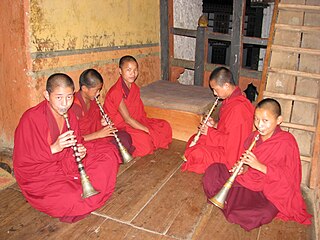
The music of Bhutan is an integral part of its culture and plays a leading role in transmitting social values. Traditional Bhutanese music includes a spectrum of subgenres, ranging from folk to religious song and music. Some genres of traditional Bhutanese music intertwine vocals, instrumentation, and theatre and dance, while others are mainly vocal or instrumental. The much older traditional genres are distinguished from modern popular music such as rigsar.

The culture of Nepal encompasses the various cultures belonging to the 125 distinct ethnic groups present in Nepal. The culture of Nepal is expressed through music and dance; art and craft; folklore; languages and literature; philosophy and religion; festivals and celebration; foods and drinks.

Exorcism is the religious or spiritual practice of evicting demons, jinns, or other malevolent spiritual entities from a person, or an area, that is believed to be possessed. Depending on the spiritual beliefs of the exorcist, this may be done by causing the entity to swear an oath, performing an elaborate ritual, or simply by commanding it to depart in the name of a higher power. The practice is ancient and part of the belief system of many cultures and religions.
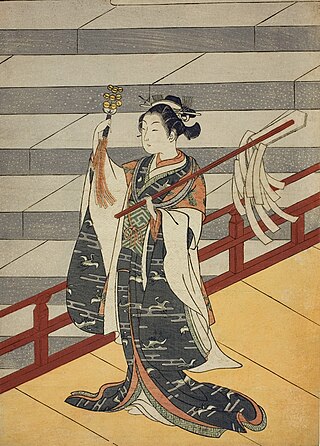
Kagura is a type of Shinto ritual ceremonial dance. The term is a contraction of the phrase kami no kura, indicating the presence of gods in the practice.

Thiksey Monastery or Thiksey Gompa is a Buddhist monastery affiliated with the Gelug school of Tibetan Buddhism. It is located on top of a hill in Thiksey approximately 19 kilometres (12 mi) east of Leh, in the Ladakh region of northern India. It is noted for its resemblance to the Potala Palace in Lhasa, Tibet, and is the largest monastery in central Ladakh, notably containing a separate set of buildings for female renunciates that has been the source of significant recent building and reorganization.
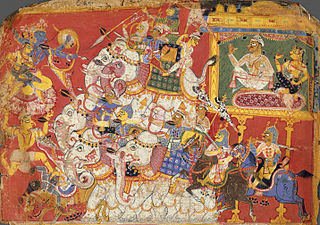
Naraka Chaturdashi is an annual Hindu festival that falls on Chaturdashi of the Krishna Paksha in the Hindu calendar month of Ashvin or Kartika. It is the second day of the five-day long festival of Diwali. Hindu literature narrates that the asura (demon) Narakasura was killed on this day by Krishna and Satyabhama. The day is celebrated by early morning religious rituals, and festivities follow on.

Kali or Kalika is a major Hindu goddess associated with time, change, creation, power, destruction and death in Shaktism. Kali is the first of the ten Mahavidyas in the Hindu tantric tradition.
Gurung Shamanism is arguably one of the oldest religions in Nepal. It describes the traditional shamanistic religion of the Gurung people of Nepal. There are three priests within the Gurungs which are Pachyu, Khlepree and Bonpo Lama. Tamus do not have a written script; nowadays they use the Devanagari script. However, the Tamus have created their own script called 'Khema Script' which is taught in Rupandehi, Nepal, and is widely taught even in overseas countries like Sikkim, India. The pronunciation of the word 'Pachyu' and 'Khlepree' are often different from one village to another. Pachyu are sometimes referred to as 'Poju or Pajyu' and Khlepree is also known as 'Lhori or Ghyabri'. Bonpo Lamais the proper term for a Gurung Lama. The "Pachyu" is understood to be the first priest amongst the three priests followed by Khlepree and lastly the Bonpo Lam. Pachyu, Khlepree and Bonpo Lams' recite chants of ancient legends and myths. These sacred myths and legends within the Pe are historical events and stories which dates back to as early as the creation of Earth to stories that have occurred within the Gurung societies as they are one of the indigenous people of Nepal.
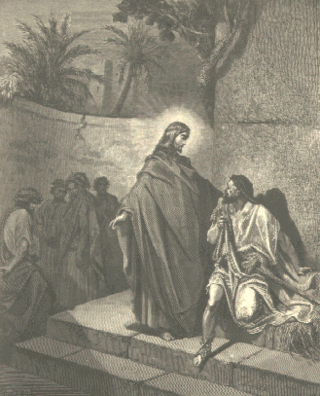
In Christianity, exorcism involves the practice of casting out one or more demons from a person whom they are believed to have possessed. The person performing the exorcism, known as an exorcist, is often a member of the Christian Church, or an individual thought to be graced with special powers or skills. The exorcist may use prayers and religious material, such as set formulas, gestures, symbols, icons, or amulets. The exorcist often invokes God, Jesus, angels and archangels, and various saints to aid with the exorcism. Christian exorcists most commonly cast out demons in Jesus' name.
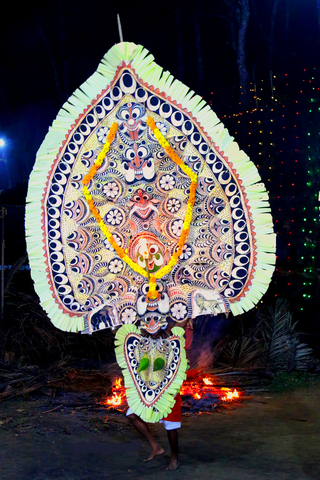
Padayani, also known Padeni, is a traditional folk dance and a ritual art from the central portion of the Indian state of Kerala. A ceremonial dance involving masks, it is an ancient ritual performed in Bhagavati temples. The dance is performed in honor of Bhadrakaali. Meaning, a 'row of warriors', Padayani is an art form that blends all music, dance, theatre, satire, facial masks, and paintings. It is part of worship of Bhadrakali and is staged in temples dedicated to the goddess from mid-December to mid-May. Padayani is unique to central Travancore, comprising the Pathanamthitta and Kottayam districts of Kerala. It is also performed in adjoining regions of Kollam, Alappuzha districts.

Chhairo Monastery was the first monastery of the Nyingma school of Tibetan Buddhism founded in Upper Mustang. It was established in the 16th century and is part of present-day Mustang District, Nepal.
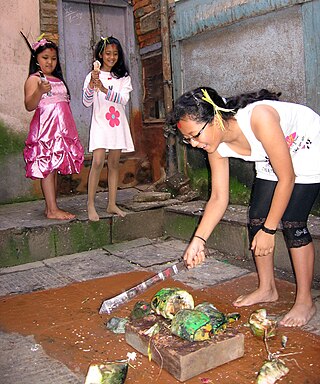
Mohani or Mohni is one of the most important festivals among the Newars which involves a packed itinerary of religious services, pilgrimages, family gatherings and outdoor celebrations lasting several days. Special dinners known as Nakhtya, to which all the relatives are invited, continue for weeks later. Mohani is the equivalent of Nepal's biggest festival Dasain, and there are similarities and differences between the two.

Chinese ritual mastery traditions, also referred to as ritual teachings, or Folk Taoism, or also Red Taoism, constitute a large group of Chinese orders of ritual officers who operate within the Chinese folk religion but outside the institutions of official Taoism. The "masters of rites", the fashi (法師), are also known in east China as hongtou daoshi (紅頭道士), meaning "redhead" or "redhat" daoshi, contrasting with the wutou daoshi (烏頭道士), "blackhead" or "blackhat" priests, of Zhengyi Taoism who were historically ordained by the Celestial Master.
Torgya, also known as Tawang-Torgya, is an annual festival that is exclusively held in Tawang Monastery, Arunachal Pradesh, India. It is held according to the Buddhist calendar days of 28th to 30th of Dawachukchipa, which corresponds to 10 to 12 January of the Gregorian calendar, and is a Monpa celebration. The objective of the festival is to ward off any kind of external aggression and to protect people from natural disasters.
The use of death horoscopes in Tibetan Buddhism is an old practice that still sees application today. There are several types of horoscopes used in this religion, including a birth horoscope, a life forecast, an annual horoscope, a marriage horoscope, and a death horoscope. When casting the death horoscope, Tibetan Buddhists place great importance on the corpse, especially within the first three days following its death. There are several purposes for a death horoscope, and carrying out this practice must be done carefully. Additionally, a death horoscope is intended as a loving act for the dead, and a precautionary measure for the family of the deceased. Many Tibetans believe that when a death occurs within the family, other family members' lives are jeopardized, so this practice may be considered essential to both the living and dead. Tibetan Buddhists also believe that their deceased loved ones may spend a short period in hell to pay for sins in their past life.
Ninabali is a ritualistic performing art form popular in Kannur, Kozhikode districts of northern Kerala, India. It is a folk art performed by the Malaya community. This art form, which is performed in homes as part of Hinuist exorcism ceremonies, depicts the battle between Bhadrakali and the asura Darika.













